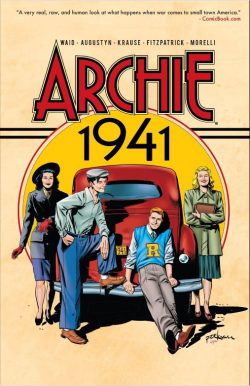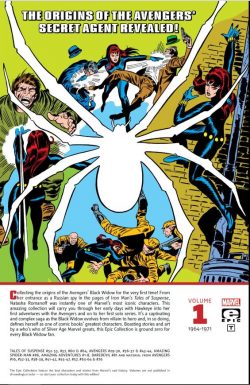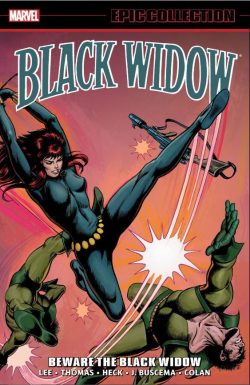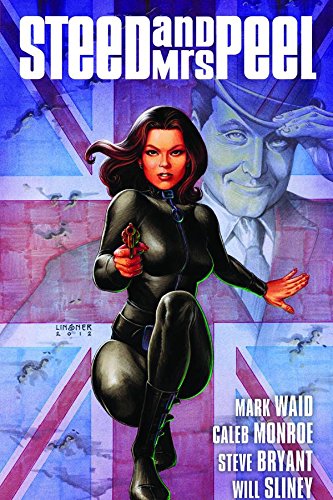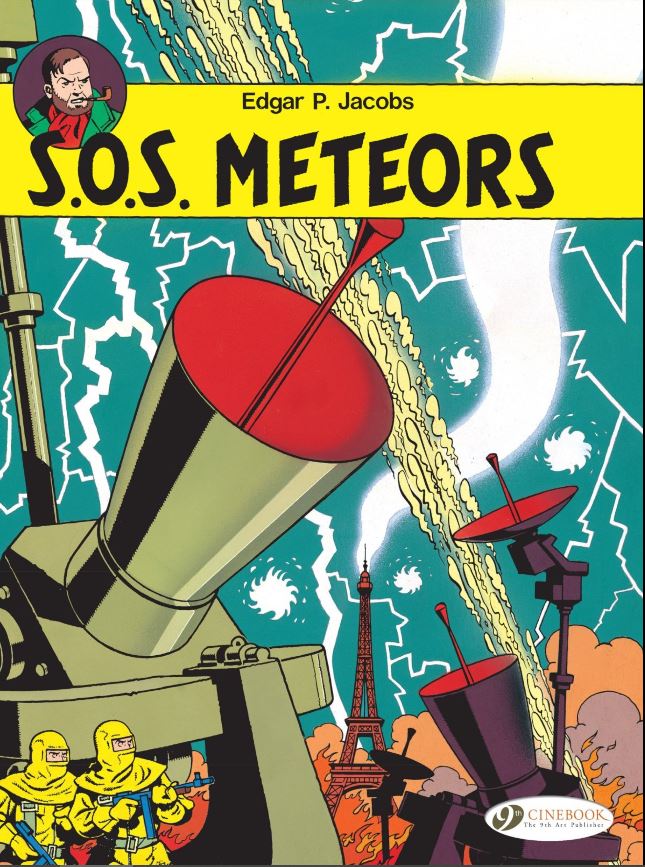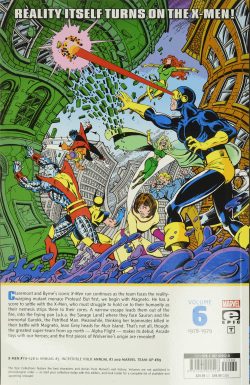
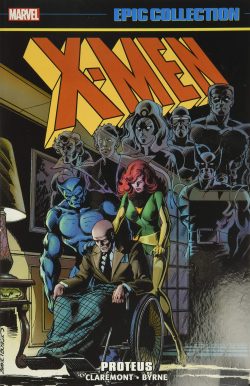
By Chris Claremont, John Byrne, Terry Austin, George Pérez, Michael Netzer, Rick Buckler & various (Marvel)
ISBN: 978-1-3029-2252-8 (TPB)
In the autumn of 1963, The X-Men #1 introduced Scott (Cyclops) Summers, Bobby (Iceman) Drake, Warren (Angel) Worthington, Jean (Marvel Girl) Grey and Hank (The Beast) McCoy: very special students of Professor Charles Xavier.
The teacher was a wheelchair-bound telepath dedicated to brokering peace and integration between the masses of humanity and the emergent off-shoot race of mutants dubbed Homo superior; considered by many who knew him as a living saint.
After nearly eight years of eccentrically spectacular adventures the mutant misfits virtually disappeared at the beginning of 1970 during another periodic downturn in superhero comics sales. Just like in the closing years of the 1940s, mystery men faded away as supernatural mysteries and traditional genre themes once more dominated the world’s entertainment fields…
Although the title was revived at the end of the year as a cheap reprint vehicle, the missing mutants were reduced to guest-stars and bit-players throughout the Marvel universe and the Beast was refashioned as a monster fit for the global uptick in scary stories until Len Wein & Dave Cockrum revived and reordered the Mutant mystique with a brand-new team in Giant Size X-Men #1 in 1975.
To old foes-turned-friends Banshee and Sunfire was added one-shot Hulk hunter Wolverine, and all-original creations such as demonic-seeming German teleporter Kurt Wagner/ Nightcrawler; African weather “goddess†Ororo Monroe AKA Storm; Russian farmboy Peter Rasputin who transformed at will into a living steel Colossus and bitter, disillusioned Apache superman John Proudstar who was cajoled into joining the makeshift squad as Thunderbird.
The revision was an instantaneous, incontrovertible hit. With Wein’s editorial assistant Chris Claremont writing the series from the second story onwards, the Uncanny X-Men reclaimed their own comicbook within months (#94). It quickly became the company’s most popular – and highest quality – title.
Cockrum was succeeded by John Byrne and as the team roster shifted and changed the series rose to even greater heights, culminating in the landmark (and with this tome, imminently ensuing) Dark Phoenix storyline which saw the death of arguably the book’s most beloved and imaginative character.
In the aftermath team leader Cyclops left, but the epic cosmic saga also seemed to fracture the epochal working relationship of Claremont & Byrne. Within months of publication, they went their separate ways: Claremont staying with the mutants whilst Byrne moved on to establish his own reputation as a writer on series such as Alpha Flight, Incredible Hulk and especially his revolutionised and freshly-groundbreaking Fantastic Four…
After Apache warrior Thunderbird became the team’s first fatality, the survivors slowly bonded, becoming an infallible fighting unit under the brusque and draconian supervision of Cyclops.
This monolithic trade paperback – and eBook – compilation is the ideal artefact for newbies, neophytes and even old lags nervous about reading such splendid yarns on fragile, extremely valuable newsprint paper. It celebrates the unstoppable march to market dominance through the pivotal early stories: specifically, X-Men #111-128 and Annual #3 of the decidedly “All-New, All-Different†ones, plus crossover yarns from Marvel Team-Up #89 and The Incredible Hulk Annual #7 – all cumulatively spanning June 1979-March 1980.
The drama kicks off with that Hulk Annual as ‘The Evil That is Cast…’ by Roger Stern, Byrne & Bob Layton finds retired X-Men Angel and Iceman targeted by a madly-mutated, mutant-hunting Sentinel Master Mold, who has merged with a manic former foe. Happily, the peripatetic pistachio powerhouse is on hand to balance the odds…
Meanwhile, the modern members are the subject of ‘Mindgames’ (Claremont, Byrne & Terry Austin) with Avenging alumnus The Beast visiting a circus in search of the new team. They have been missing for weeks…
His presence disrupts a devilish scheme by mutant hypnotist Mesmero to subjugate the heroes through false memories and implanted personalities, but the reawakened stalwarts’ vengeance is forestalled as their greatest enemy ambushes them…
X-Men #112 finds the revived and furious heroes fighting but failing, leaving ‘Magneto Triumphant!’ With his enemies helplessly imprisoned miles beneath Antarctica, a valiant turnabout and escape results in tense, action-packed battle bonanza ‘Showdown!’ On the Polaric tyrant’s return – after terrorising the humans of Australia – the X-Men have broken free and are waiting for him…
In the apocalyptic battle which follows the base is utterly destroyed and Magneto grievously wounded. With boiling lava flooding everywhere, only Beast and recently-ascended Phoenix Jean Grey manage to reach the surface to realise, in horror, that they are the only survivors.
They could not be more wrong…
Unable to go up, their fellow champions tunnel downwards and ‘Desolation!’ turns to joy as they emerge into the antediluvian wilderness dubbed the Savage Land. Linking up with old ally Ka-Zar, the X-Men slowly recover in a dinosaur-filled, elysian paradise. The idyll is rudely shattered when former foe Karl Lykos succumbs to his old addiction and absorbs their mutant energies to become lethal leather-winged predator Sauron…
His ‘Visions of Death!’ are readily dispelled by the assembled heroes, but he’s just the first course in a campaign of terror as crazy, colonialising barbarian queen Zaladane revives proto-god Garokk as the figurehead of her army of conquest…
When the insane imperialists’ eco-meddling disrupts the tropical climate of the sub-polar region, Ka-Zar and the X-Men invade their noxious citadel ‘To Save the Savage Land’. The brutal battle demands the best and worst from the young warriors before the job is done…
With the distasteful task completed, the mutants opt for a perilous sea-passage back to the outside world…
Uncanny X-Men #117 begins with their rescue by an Antarctic exploration vessel, heralding a slow torturous voyage to Japan, before lapsing into an untold tale of Charles Xavier in his globe-trotting days prior to losing the use of his legs. ‘Psi War!’ is full of clever, in-filling insights as it details how the dispirited, restless young telepath fetches up in Cairo and meets his first “Evil Mutantâ€â€¦
Amahl Farouk uses psionic abilities to rule the city’s underworld: a depraved, debauched monster who thinks he is beyond justice. The enraged, disgusted Xavier defeats the beast and in doing so find his life’s purpose…
A revelatory 2-part epic follows as the X-Men – still believed dead by Xavier, Jean and the wider world – arrive in Agarashima, just as the port is being devastated by a vast firestorm. Inked by Ricardo Villamonte, ‘The Submergence of Japan!’ sees tectonic terrorist Moses Magnum undertake a most audacious blackmail scheme, countered by the valiant mutants who briefly reunite with old – and still belligerently surly – comrade Sunfire.
Perhaps he is just surprised to discover Wolverine has unsuspected connections to Japan and has turned the head of local highborn maid Lady Mariko. A bigger surprise awaits the American specialist the government have brought in. Misty Knight is Jean Grey’s roommate in Manhattan and grieved with her at the X-Men’s reported deaths. Now she has to tell Cyclops his girl has moved on and Professor X has quit Earth for the Shi’ar Empire…
Of course, all that is moot if they can’t stop Magnum and his Mandroid army sinking Japan into the Pacific, but after a catastrophic conflict inside a volcano there’s a seasonal reunion in store for all in the Austin-inked ‘Twas the Night Before Christmas…’
Marvel further expands its borders with the introduction of a foreign super-squad in ‘Wanted: Wolverine! Dead or Alive!’, as enigmatic wild man Logan – accompanied by Cyclops, Nightcrawler, Storm, Colossus, Banshee and Nightcrawler – returns from bombastic battle and heartbreak in Japan only to be herded into Canadian airspace so the Ottawa government can reclaim their former property…
Forced down by a magical tempest, the X-Men are soon on the run in Calgary, ambushed by the aforementioned Alpha Flight – specifically battle-armoured Vindicator, gamma-powered, super-strong Sasquatch, First Nations magician Shaman, shapeshifting Snowbird and mutant speedster twins Northstar and Aurora: all ordered to repossess at any cost former special operative and top agent “The Wolverineâ€â€¦
After a brutal but inconclusive clash at the airport, the X-Men fade into the city but only after Wolverine and Nightcrawler are captured…
The retaliation results in a ‘Shoot-Out at the Stampede!’, with the mutants confronting their pursuers while Shaman’s eldritch blizzard spirals out of control, threatening to destroy the entire province. Even after Storm fixes the problem, the Canadians are adamant, so to end hostilities Wolverine surrenders himself in return for his comrades’ safe passage.
Of course, he never promised to stay arrested…
The drama resumes with Byrne producing light breakdowns and regular inker Terry Austin stepping up to produce full art finishes for issue #122’s ‘Cry for the Children!’ as the long-gone heroes finally return to the Xavier School only to find it boarded up and deserted.
Months previously, following the catastrophic battle against Magneto, heartbroken Professor X had grieved for his fallen pupils and left Earth to be with his fiancée Empress Lilandra of the far-flung extragalactic Shi’ar Imperium. In the interim, Jean Grey – reborn as the cosmic-powered Phoenix – went globetrotting to bury her woes. She is currently in Scotland, unaware that she has been targeted by one of the team’s oldest enemies for a cruel assault…
As the weary team slowly settle in at the mansion again, attempting to return to previous routines, psychological stress testing shows Russian teen Colossus has second thoughts about deserting his family and country…
In New York, Storm is tracing her roots, visiting the old home of her American father, only to find it now a vile junkie squat filled with doped-up, feral kids who viciously attack her. Stabbed and bleeding, she lashes out and only the sudden arrival of hero for hire Luke Cage and his friend Misty Knight prevents a tragedy. None of them are remotely aware that they have been targeted by the world’s most outrageous hit-man…
With Byrne back in full penciller mode, #123 includes a cameo from Spider-Man as jolly psycho-killer Arcade picks off the oblivious mutants and runs them through his fatal funfair Murder World in ‘Listen… Stop Me if You’ve Heard It… But This One Will Kill You!’: subjecting the abductees to perils mechanical and psychological.
The former proves understandably ineffectual, but family guilt and cunning conditioning soon transform the already homesick and despondent Colossus into a vengeful mind-slave dubbed The Proletarian, determined to smash his former comrades in concluding chapter ‘He Only Laughs When I Hurt!’ Happily, his inner child and the assorted heroes’ gifts and training prove too much for the maniacal killer clown…
Marvel Team-Up #89 then diverts to a follow-up as Claremont, Michael Nasser/Netzer, Rick Buckler & Josef Rubinstein depict a ‘Shoot-Out over Center Ring!’ as the wallcrawler and former acrobat Kurt Wagner again clash with Arcade and assassin Cutthroat at the circus…
X-Men Annual #3 then offers a fantastic interlude as extradimensional barbarian warlord Arkon the Magnificent returns to Earth courtesy of Claremont, George Pérez & Austin. ‘A Fire in the Sky!’ sees him again seeking to save his unstable world of Polemachus from eternal darkness. Last time, Avenger Thor provided the lightning necessary to illuminate his realm, but with the Asgardian unavailable, Arkon decides Storm will do. He never learned how to ask, though, and his violent abduction of his target provokes a furious response from her mutant comrades…
With Byrne back drawing, Jean re-enters the picture in X-Men #125, when her stay with geneticist Moira MacTaggertleads to the release of a long-secret family shame in ‘There’s Something Awful on Muir Island!’ Throughout her long holiday, Phoenix has been gradually weakened and psychically seduced by a psionic predator: groomed for a life of refined cruelty and debauchery by a man calling himself Jason Wyngarde. His intention is to create a callous and wicked “Black Queen†for the mysterious organisation known as the Hellfire Club…
At the other end of the galaxy, Charles Xavier reviews records of how Phoenix once reconstructed the entire fragmenting universe and is gripped with terror at the thought of all that power in the hands of one frail human personality, whilst in his former home the Beast checks a tripped alarm and discovers his long-mourned friends are all alive.
The reunited comrades’ first thought is to tell Jean the incredible news, but no sooner is a transatlantic call connected than a scream echoes out and the line goes dead…
Issue #126 resumes frantic hours later as the X-Men approach Muir Island in their supersonic jet. With all contact lost and no telepath aboard, Cyclops assumes the worst and the squad infiltrate in battle formation, only to find a withered corpse and badly shaken comrades Lorna Dane, Havok, Madrox, Moira and Jean slowly recovering from a psionic assault. In ‘How Sharper Than a Serpent’s Tooth…!’ Dr. MacTaggert bitterly reveals the attacker is a psychic bodysnatcher imprisoned on Muir for years. He’s also her son…
Rapidly burning out one of Madrox’s duplicate bodies, the monster has already reached the Scottish mainland, but as the mutants disperse to hunt him down Jean is hampered by a torrent of seductive mirages projected by the smugly confidant Wyngarde, allowing predatory Proteus to ambush the X-Men and attempt to possess Wolverine.
It is his first mistake. Metal has an inimical effect on the formless horror and the feral fury’s Adamantium skeleton forces him to flee his victim in screaming agony. It is then the creature unleashes his most terrifying power: warping reality to drive Wolverine and Nightcrawler to the brink of madness. Only the late-arriving Storm prevents their immediate demise but soon she too is at the edge of destruction…
‘The Quality of Hatred!’ finds the badly shaken team undergoing desperate “tough-love†remedies from Cyclops to regain combat readiness, whilst Moira tries to make up for her dangerous sentimentality by putting a bullet into her deadly offspring.
Frustrated by the idealistic Cyclops but having divined the path Proteus is taking, she then heads for Edinburgh and an unpleasant reunion with her former husband: brute, bully, Member of Parliament and father of most merciless monster the world has yet produced…
As Jean finally shrugs off her distractions and telepathically homes in on Proteus, the team swing into action a little too late: the sinister son has possessed his scurrilous sire and created an unstoppable synthesis of world-warping abomination…
With Edinburgh and perhaps the entire world roiling and rebelling as science goes mad, X-Men #128 sees the valiant champions strike back to spectacularly triumph in ‘The Action of the Tiger!’ : scoring a hard-fought but bittersweet victory…
Also offering original art, fanzine covers, portfolio pages, previous collection artwork and a barrage of house ads, this is a stunning treasure trove of action and adventure. For many fans these tales – and those in the next volume – comprise the definitive X-Men look and feel: some of the greatest stories Marvel ever published; entertaining, groundbreaking and utterly intoxicating. These stories are an invaluable grounding in contemporary fights ‘n’ tights fiction no fan or casual reader can afford to ignore.
© 2020 MARVEL.

